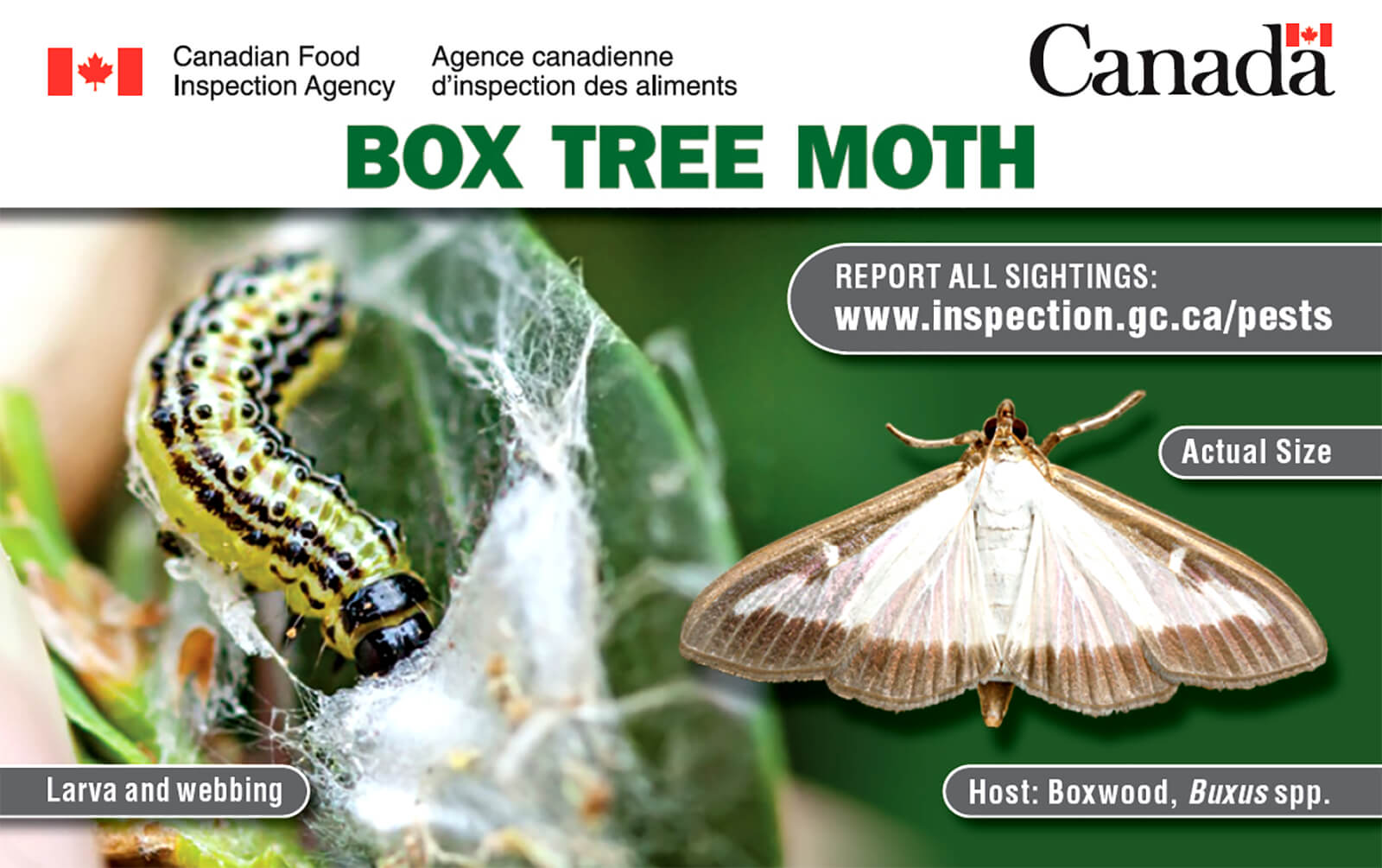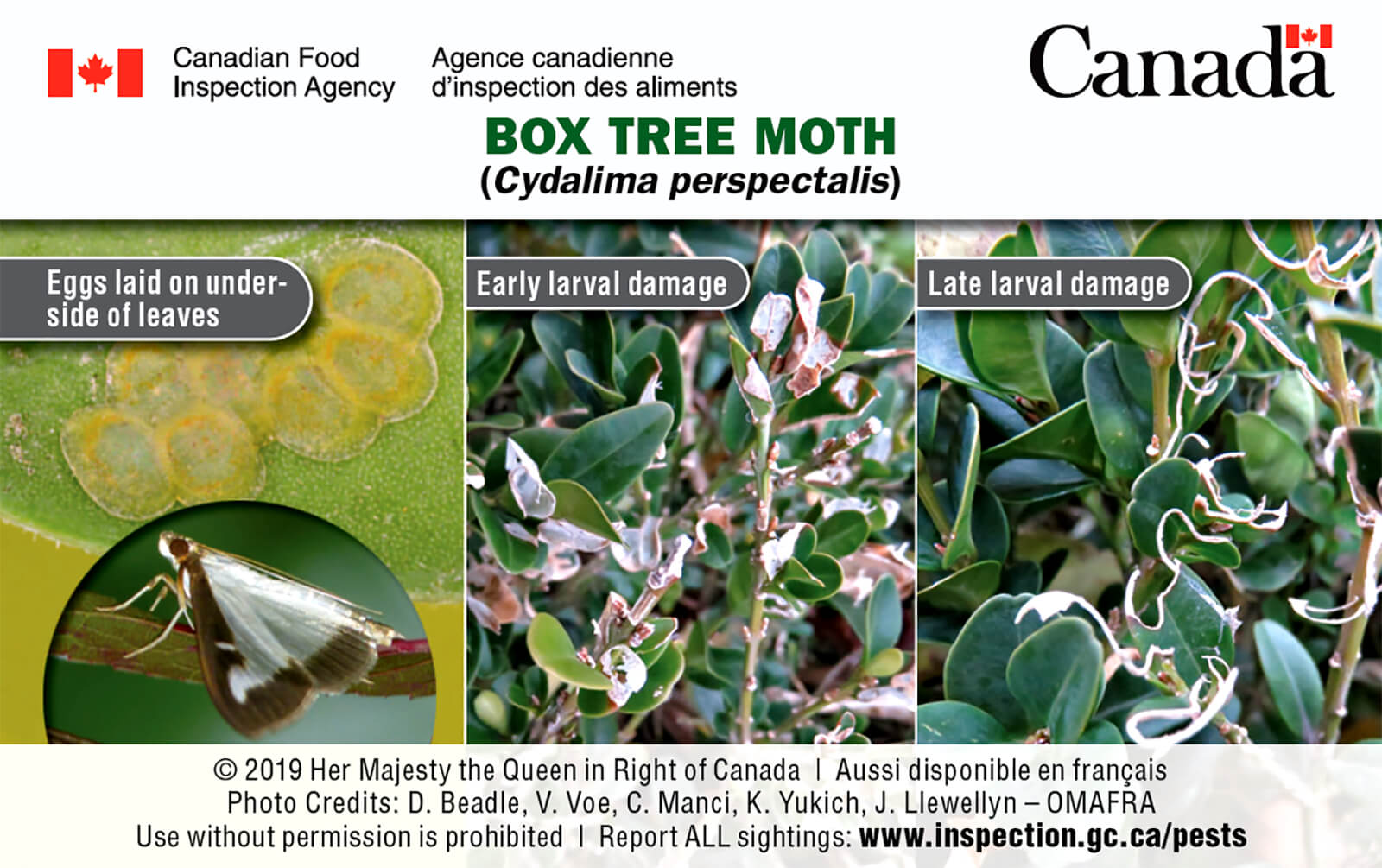September 8, 2020
Resources to help landscape pros identify, remove and rejuvenate boxwood infested with box tree moth
Dear landscape professional,
This message is regarding the new urban landscaping pest: box tree moth (Cydalima perspectalis). This pest has the potential to defoliate and create dieback on boxwood (buxus) plants. At the moment, all sightings must be reported to the Canadian Food Inspection Agency (CFIA). (See Report a Sighting below).
Box Tree Moth was first identified in southern Etobicoke (GTA) during the fall of 2018.
As of 2020, this pest has spread throughout the GTA. In addition to the core area where it was initially reported, box tree moth is now found in downtown Toronto, North York, Mississauga, and Scarborough. There have also been unconfirmed reports in Brampton. We understand that you may have clients in these areas, and we would like to give you the tools you need to help them preserve their boxwoods.
Here are some resources that may help with identification, removal, and boxwood rejuvenation after feeding damage.
Please review Jennifer Llewellyn's video to help with identification:
HortTrades.com/box-tree-moth-webinar-and-online-discussion
A document regarding the disposal of infested boxwood:
HortTrades.com/safe-removal-of-boxwood-affected-by-box-tree-moth
A document regarding the rejuvenation of damaged boxwood:
HortTrades.com/rejuvenating-boxwood-plants-damaged-by-box-tree-moth
Box tree moth can have up to three lifecycles each season. The most effective way to control infestation is through spraying the biological product Dipel (BT) or BTK during larval periods. We have identified larval periods below.
Please ensure there are box tree moth larvae on the boxwood before spraying as other life stages are not affected by Dipel (BT) or BTK.
Emily Wrobel
Box Tree Moth Coordinator
Landscape Ontario
Report a sighting to the Canadian Food Inspection Agency: inspection.gc.ca/pests
This message is regarding the new urban landscaping pest: box tree moth (Cydalima perspectalis). This pest has the potential to defoliate and create dieback on boxwood (buxus) plants. At the moment, all sightings must be reported to the Canadian Food Inspection Agency (CFIA). (See Report a Sighting below).
Box Tree Moth was first identified in southern Etobicoke (GTA) during the fall of 2018.
As of 2020, this pest has spread throughout the GTA. In addition to the core area where it was initially reported, box tree moth is now found in downtown Toronto, North York, Mississauga, and Scarborough. There have also been unconfirmed reports in Brampton. We understand that you may have clients in these areas, and we would like to give you the tools you need to help them preserve their boxwoods.
Here are some resources that may help with identification, removal, and boxwood rejuvenation after feeding damage.
Please review Jennifer Llewellyn's video to help with identification:
HortTrades.com/box-tree-moth-webinar-and-online-discussion
A document regarding the disposal of infested boxwood:
HortTrades.com/safe-removal-of-boxwood-affected-by-box-tree-moth
A document regarding the rejuvenation of damaged boxwood:
HortTrades.com/rejuvenating-boxwood-plants-damaged-by-box-tree-moth
Box tree moth can have up to three lifecycles each season. The most effective way to control infestation is through spraying the biological product Dipel (BT) or BTK during larval periods. We have identified larval periods below.
- May 15 to June 15
- July 15 to Aug. 15
- Sept. 1 to 20
Please ensure there are box tree moth larvae on the boxwood before spraying as other life stages are not affected by Dipel (BT) or BTK.
Emily Wrobel
Box Tree Moth Coordinator
Landscape Ontario

